hydrogel
Latest
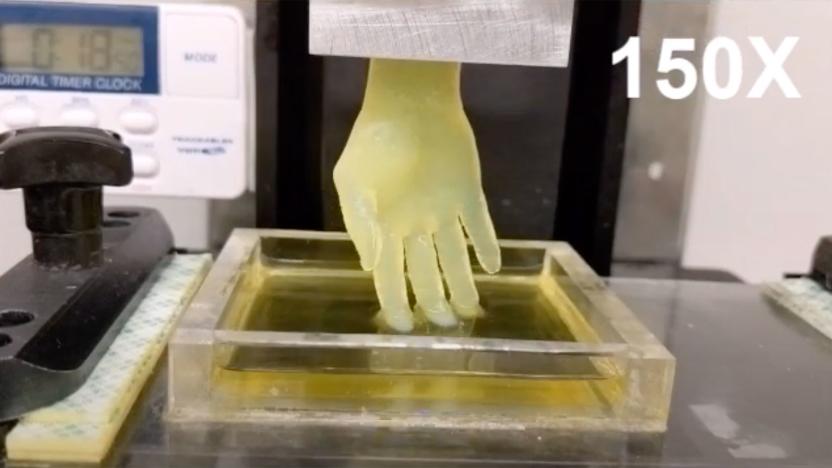
New 3D printing technique could make lab-grown organs more practical
A fast 3D printing technique could lead to healthy lab-grown organs that are ready in minutes rather than hours.

MIT’s thread-like robot can slip through blood vessels in your brain
MIT engineers created a thread-like robot that can glide through the brain's blood vessels and could deliver clot-reducing drugs to treat strokes or aneurysms. The robotic thread could offer an alternative to open brain surgery, and it could be controlled by surgeons outside of the operating room. Theoretically, surgeons could control it remotely from an entirely different location.

Scientists bioprint living tissue in a matter of seconds
Bioprinting holds great potential for repairing injuries, testing drugs or replacing whole organs, but it's currently limited in complexity, viability and speed -- you can't just create tissue on a whim. Soon, though, it might be a matter of crafting whatever you need when you need it. Scientists at EPFL and University Medical Center Utrecht have developed an optical system that can bioprint complex, highly viable living tissue in "just a few seconds." It would represent a breakthrough compared to the clunky, layer-based processes of today.

Scientists create gut gel 'band-aid' made from the body's own bacteria
If you get a cut on your skin, you stick a band-aid on it. But what if you get a wound in your gut? When doctors treat injuries to the intestines, they can't use patches or bandages because these materials don't stick to the slippery intestinal walls. Now, a team from Harvard University has come up with a solution for this problem by using the body's own bacteria in a gel form.
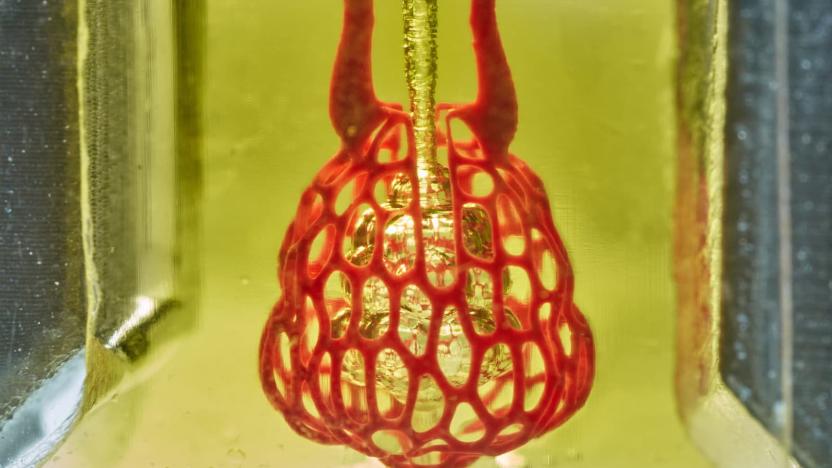
Bioengineers 3D print complex vascular networks
Bioengineers are one step closer to 3D printing organs and tissues. A team led by Rice University and the University of Washington have developed a tool to 3D print complex and "exquisitely entangled" vascular networks. These mimic the body's natural passageways for blood, air, lymph and other fluids, and they will be essential for artificial organs.

Self-healing 3D-printed gel has a future in robots and medicine
Robots might be a little more appealing -- and more practical -- if they're not made of hard, cold metal or plastic, but of a softer material. Researcher at Brown University believe they've developed a new material that could be ideal for "soft robotics." It's already demonstrated that it can pick up small, delicate objects, and it could form customized microfluidic devices -- sometimes called "labs-on-a-chip" and used for things like spotting aggressive cancers and making life-saving drugs in the field.
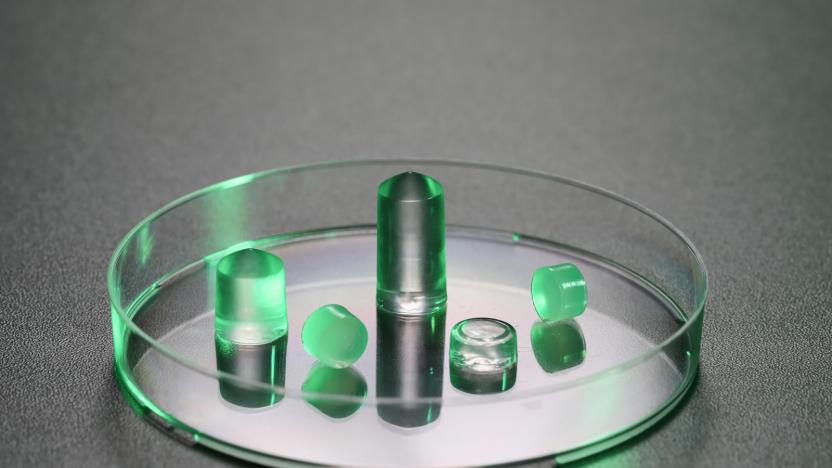
Sticky hydrogel could revolutionize knee surgery
Two teams of researchers from the École Polytechnique Fédérale de Lausanne (EPFL) have created a material that can help heal damaged cartilages more effectively. See, when a cartilage gets damaged, it needs all the extra help it can get. It doesn't heal itself like other soft tissues do, so any injury that involves one requires medical intervention. That's why scientists continue to look for better methods and materials to treat cartilage-related injuries, and one technique they came up with is injecting damaged areas with a hydrogel material loaded with either drugs or repair cells.

MIT researchers made a living ink that responds to its surroundings
Researchers at MIT have developed a 3D printable hydrogel that can sense and respond to stimuli. The hydrogel is loaded with bacteria that can be genetically programmed to light-up when they come in contact with certain chemicals and, therefore, could be used as living sensors.
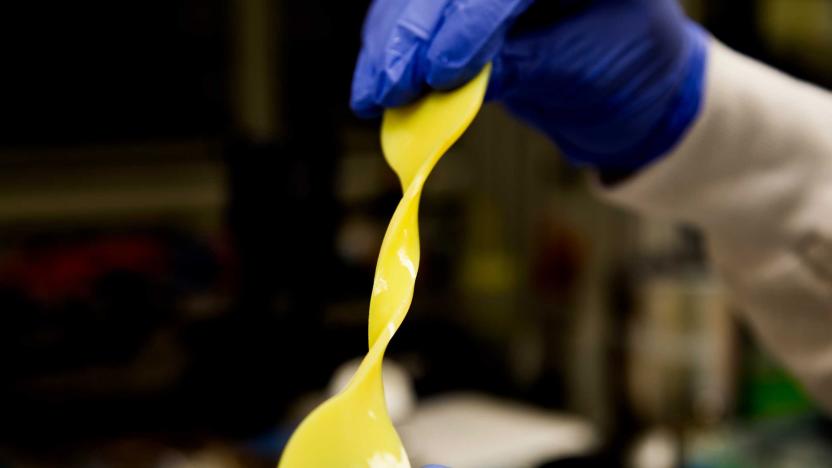
Kevlar cartilage could help you recover from joint injuries
It can be difficult to fully recover from knee injuries or other damage to your joints, if just because there hasn't been an artificial replacement for cartilage that can withstand as much punishment as the real thing. That may not be an issue in the long run, though: scientists have developed a Kevlar-based hydrogel that behaves like natural cartilage. It mixes a network of Kevlar nanofibers with polyvinyl alcohol to absorb water at rest (like real cartilage does in idle moments) and become extremely resistant to abuse, but releases it under stress -- say, a workout at the gym.
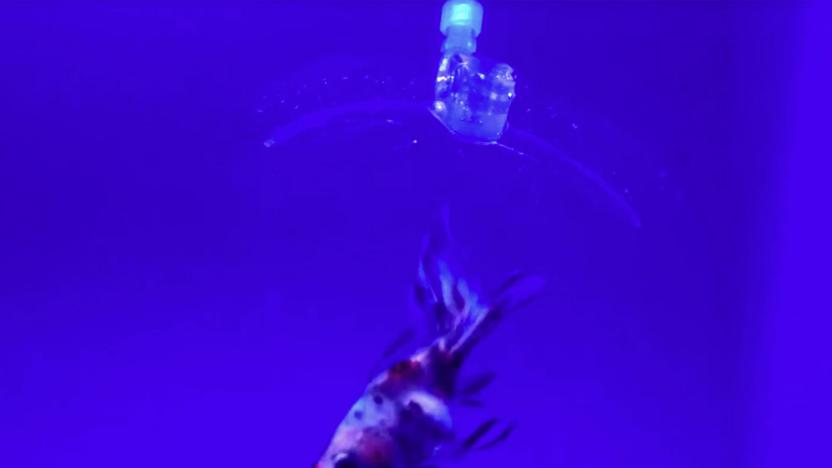
Gel-based robot hand can grab and release fish
Most robot limbs aren't exactly kind to the organic world given all that unforgiving metal, and even rubber-based soft robots aren't very gentle. However, MIT has a better way. It recently built a hydrogel-based soft robot hand that's bio-friendly while remaining tough enough to withstand heavy use. The trick was to use 3D printing and laser cutting to weave hydrogel "recipes" into robotic structures, and pump water into those structures to make them curl or stretch. The results are mostly water-based fingers that still have the strength, durability and speed of more conventional robots.

ICYMI: This rock-armored insect could change medicine
try{document.getElementById("aol-cms-player-1").style.display="none";}catch(e){}Today on In Case You Missed It: Researchers at the University of California, Berkeley discovered that an insect called the caddisfly spins strong, stretchy silk that works like a biological sticky tape. The caddisfly uses it to attach stones to its body to protect it underwater; humans are more interested in the fact that the waterproof adhesive might have medical applications. The publication Deep Look made a great video of the bug's underwater life that's worth a full watch if you're interested.

Cotton candy machines help create artificial organs
You may have seen some pretty unusual ways to make artificial organs, but Vanderbilt University might have just topped them all. Its researchers have developed a technique for making the templates of artificial organs using a cotton candy machine -- that's right, the machine whipping up treats at the county fair could effectively save your life. The team discovered that the same centrifugal process that melts sugar into delicious, fluffy strands also turns hydrogel into cell-friendly microfibers that behave like capillaries in the human body.

Biobots made from tissue could one day be implanted in humans
It turns out that robots don't need to be BigDog-sized to be freaky. Scientists at the University of Illinois have created one a mere centimeter (half-inch) in size built on a 3D-printed hydrogel backbone. The "ew" part is what powers it: a strip of skeletal muscle cells triggered by an electric current. Previous biobots built with heart tissue couldn't be controlled, but muscle cells can be activated with electric pulses and made to "walk" at different speeds by varying the frequency. If that's not making you queasy yet, how about this: the researchers think that such devices could be used for surgical robots, mobile environment detectors and even "programmable tissue engineering." That sounds like a noble goal, but we imagine Cyberdyne Systems thought the same thing.
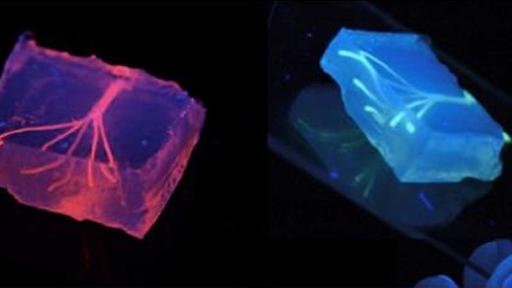
Researchers are using 3D printers to make blood vessels
There has been talk of printing blood vessels for a few years, but it's tricky to make tissue that fits the complex shapes of a human body while remaining effective. However, a research team at Brigham and Women's Hospital may have licked that problem: they've 3D printed vessels using a new technique that allows for intricate yet capable designs. Their process first prints agarose (sugar-based molecule) fibers as templates for the vessels, and then covers that in jelly-like hydrogel to produce a cast. Since the agarose is sturdy, scientists can pull it out to create channels without damaging any cells inside the gel; the resulting vessels are much better at transporting liquid and otherwise behaving like the real deal.

New medical gel grows bone tissue exactly where you need it
Repairing seriously damaged bones is normally a delicate art; while you want to regrow bones quickly, you also have to carefully manage that growth to produce the right shape. Thankfully, Rice University has created a gel that makes it easier to produce only the bone tissue a patient needs. The material kickstarts bone regeneration using a patient's stem cells, but it also dictates where that growth occurs by forming a scaffold that degrades only when tissue takes its place. Effectively, doctors just have to fill an area with the gel and wait for nature to do the rest. The technique should initially be useful for repairing skull damage, but it's likely to be handy for both less vital operations and cosmetic surgery -- don't be surprised if doctors can eventually give you a facelift by reshaping your cheekbones. [Image credit: Jeff Fitlow/Rice University]

Princeton crafts a 3D printed bionic ear with super hearing, creepy looks
Scientists have toyed with printing ear implants for ages, but they've usually been more cosmetic than functional. Princeton has just developed a bionic ear that could transcend those mere replacements to offer a full-on upgrade. Rather than seed hydrogel with cells and call it a day, the researchers 3D printed a blend of calf cells, hydrogel and an integrated, coiled antenna made from silver nanoparticles. The frankly spooky project doesn't resemble a natural ear all that closely, but it merges organic and synthetic more gracefully than inserting a chip into an existing implant. It can also expand hearing beyond normal human levels: the experimental version picks up radio waves, for example. Although the ear is just the first step on a long path toward natural-feeling bionics, it already has us wondering if we'll be actively seeking out replacement body parts in the future... not that we're about to go all Van Gogh to get them.

Georgia Tech models swimming, cargo-carrying nanobots
The nanobot war is escalating. Not content to let Penn State's nanospiders win the day, Georgia Tech has answered back with a noticeably less creepy blood-swimming robot model of its own, whose look is more that of a fish than any arachnid this time around. It still uses material changes to exert movement -- here exposing hydrogels to electricity, heat, light or magnetism -- but Georgia Tech's method steers the 10-micron trooper to its destination through far more innocuous-sounding flaps. Researchers' goals are still as benign as ever, with the goal either to deliver drugs or to build minuscule structures piece-by-piece. The catch is that rather important mention of a "model" from earlier: Georgia Tech only has a scientifically viable design to work from and needs someone to build it. Should someone step up, there's a world of potential from schools of tiny swimmers targeting exactly what ails us.

Glucose sensor skin implant glows when blood sugar spikes
Checking blood glucose levels used to mean a finger prick and a test-strip, but researchers at the University of Tokyo are offering a different approach: a glowing skin implant. After being injected with the 1 mm wide filament, it monitors your blood sugar by glowing when your level changes. Based on existing glowing glucose sensor technology, this hydrogel fiber is considered more accurate and stable than its predecessors, plus it requires no oxygen to function. So far, it's worked in mice for up to 140 days. Note to future human patients: don't eat a candy bar before you go to bed unless you want your arm looking like a nightlight.

Researchers grow crops on super thin film, do away with that pesky soil stuff
Here's the problem with plants: they require dirt which is, well, dirty. Japanese researchers at Mebiol have figured out a way to grow small crops of Earthly flora on clean sheets of hydrogel (commonly found in diapers), called Imec, that measures just tens of microns thick. Roots grow along the membrane, absorbing water through it, but the material is able to block out bacteria and viruses that could harm the plants. Of course, there are downsides. Water is absorbed at a much lower rate through the gel than with traditional soil, so plant size is limited and only the strongest and healthiest varieties can truly thrive on the flexible sheets. By using carefully selected plants and high quality fertilizer though, researchers were able to grow tomatoes, spinach and even melons, and hope to strengthen the film enough to support trees. Not bad for a substance normally used to absorb baby pee. Check out the video after the break.

Implantable blood sugar sensor could eliminate daily finger pricks
Science has been figuring out ways to sidestep those dreaded finger pricks for years now, but it's not often that we hear of such a permanent solution as this. A crew of researchers from The University of Tokyo and BEANS Research Institute are in the process of developing a newfangled blood sugar sensor that "reacts to glucose and lights up inside the body." 'Course, injecting dyes into humans in order to receive interpretable signals ain't exactly new, but hydrogel is what makes this approach unique. As the story goes, this jelly-esque material can be implanted within the body, enabling blood sugar levels to be monitored and measured externally with no pain or irritation whatsoever. In theory, a monitoring system could trigger an alert as soon as the internal levels dipped or rose beyond a predetermined extreme, giving those with diabetes a maximum amount of time to get things back in balance. There's nary a mention of when this goo will be green-lit by the FDA, but there's definitely a video explaining everything just past the break.









